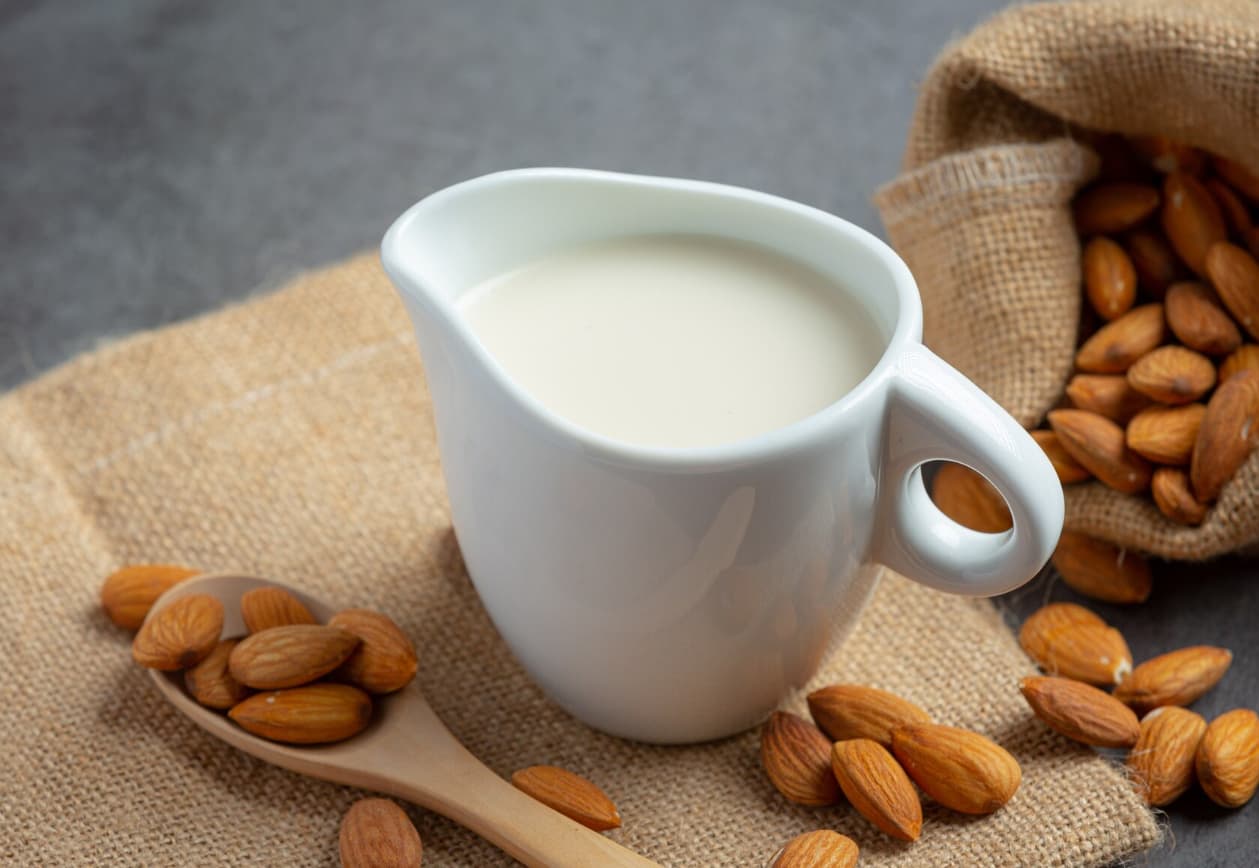Almond milk has become a popular choice for many, offering a tasty and nutritious alternative to dairy milk.
While it’s easy to grab a carton from the store, making your almond milk at home can be a rewarding and healthier option. Homemade almond milk is free from additives and preservatives, allowing you to enjoy a purer, fresher taste.
Creating your almond milk is surprisingly simple. With just a few basic ingredients and some common kitchen tools, you can whip up a batch in no time.
The process involves soaking almonds, blending them with water, and straining the mixture to produce creamy, delicious milk.
By making almond milk at home, you have full control over the ingredients. You can adjust the sweetness, creaminess, and flavor to suit your taste. Plus, it’s a great way to reduce packaging waste and save money in the long run.
In this guide, we’ll walk you through the step-by-step process of making healthy almond milk at home.
We’ll cover everything from selecting the best almonds to storing your finished product. Let’s dive in and discover how easy and satisfying it can be to make your almond milk!
How to Make Healthy Almond Milk At Home?

Almond milk is a plant-based milk made from ground almonds and water. It’s a great option for those who are lactose intolerant, following a vegan diet, or simply looking to try something new.
Store-bought almond milk often contains additives and preservatives that may not align with your health goals.
By making it at home, you have full control over the ingredients and can customize the flavor to your liking.
Benefits of homemade almond milk:
- Fresher taste
- No artificial additives
- Control over ingredients
- Customizable flavor
- More environmentally friendly (less packaging waste)
- Potentially more cost-effective in the long run
In this article, we’ll cover everything you need to know about making healthy almond milk at home, from the ingredients you’ll need to the step-by-step process.
We’ll also explore the health benefits of almond milk, answer some frequently asked questions, and provide tips for storing and using your homemade creations.
Almond Milk For Health
Before we dive into the recipe, let’s take a closer look at why almond milk can be a healthy choice for many people.
Nutritional benefits of almond milk:
- Low in calories
- Naturally lactose-free
- Contains no cholesterol
- Good source of vitamin E
- Often fortified with calcium and vitamin D
Almond milk is particularly beneficial for those with certain dietary restrictions or health concerns. Here’s a quick comparison of almond milk to cow’s milk:
| Nutrient | Unsweetened Almond Milk (1 cup) | Whole Cow’s Milk (1 cup) |
|---|---|---|
| Calories | 30-50 | 146 |
| Fat | 2.5-3g | 8g |
| Protein | 1g | 8g |
| Carbs | 1-3g | 12g |
| Calcium | 200-300mg (if fortified) | 276mg |
As you can see, almond milk is generally lower in calories, fat, and carbohydrates compared to cow’s milk. However, it’s also lower in protein, so it’s important to ensure you’re getting protein from other sources in your diet if you switch to almond milk.
Ingredients To Make Almond Milk
To make your almond milk at home, you’ll need just a few simple ingredients:
- 1 cup raw almonds
- 4 cups filtered water
- Optional additions for flavor:
- 1-2 pitted dates (for sweetness)
- 1 teaspoon vanilla extract
- A pinch of salt
Equipment needed:
- Large bowl (for soaking almonds)
- Blender or food processor
- Nut milk bag or fine-mesh strainer
- Glass bottle or jar for storage
How to Make Healthy Almond Milk At Home? Complete Steps
Step 1: Soak The Almonds
The first step in making almond milk is to soak the almonds. This process is crucial for several reasons:
- Softens the almonds: Makes them easier to blend, resulting in a creamier milk
- Removes phytic acid: An antinutrient that can interfere with mineral absorption
- Enhances digestibility: Soaking activates enzymes that make almonds easier to digest
How to soak almonds:
- Place 1 cup of raw almonds in a large bowl
- Cover the almonds with cool water (about 2 inches above the almonds)
- Let them soak for at least 8 hours or overnight
- For best results, soak for 12-24 hours in the refrigerator
Tip: If you’re short on time, you can use hot water and soak the almonds for 1-2 hours. However, the longer soaking time is preferred for optimal results.
Step 2: Drain And Rinse
After soaking, it’s important to properly drain and rinse the almonds. This step removes any residual phytic acid and prepares the almonds for blending.
How to drain and rinse almonds:
- Pour the soaked almonds into a colander
- Rinse them thoroughly under cool running water
- Gently rub the almonds between your hands to remove any loose skins (optional)
Note: Some people prefer to remove the almond skins completely for smoother milk, but this is not necessary and can be time-consuming. The skins contain beneficial nutrients and fiber.
Step 3: Blend
Now comes the fun part – blending your almonds into milk!
Blending instructions:
- Add the soaked and rinsed almonds to your blender
- Pour in 4 cups of fresh, filtered water
- Blend on high speed for 1-2 minutes, until the almonds are broken down and the mixture looks creamy
Tips for successful blending:
- Use a high-powered blender for best results
- If your blender is less powerful, you may need to blend for a longer time
- Start with less water for creamier milk, or more water for a thinner consistency
Step 4: Strain
Straining is a crucial step to remove the almond pulp and achieve smooth, creamy milk.
How to strain almond milk:
- Place a nut milk bag or fine-mesh strainer over a large bowl
- Pour the blended mixture into the bag or strainer
- If using a nut milk bag, gently squeeze to extract all the liquid
- If using a strainer, use a spoon to press the pulp and release the milk
What to do with leftover almond pulp:
- Add to smoothies for extra fiber and nutrients
- Use in baking recipes as a flour substitute
- Mix into oatmeal or yogurt
- Dehydrate and use as almond meal
Step 5: Optional Sweetening
At this point, you have pure, unsweetened almond milk. If you prefer a sweeter or more flavored milk, now’s the time to add optional ingredients.
Sweetening options:
- 1-2 pitted dates (soak in hot water for 10 minutes if they’re not soft)
- 1 tablespoon maple syrup or honey
- 1 teaspoon vanilla extract
- A pinch of salt (enhances flavor)
- 1/2 teaspoon cinnamon or other spices
To add these ingredients:
- Pour the strained milk back into the blender
- Add your chosen sweeteners or flavorings
- Blend again until smooth and well combined
Tip: Start with small amounts of sweeteners and adjust to taste. You can always add more, but you can’t take it out once it’s blended in!
Step 6: Store
Proper storage is key to keeping your homemade almond milk fresh and tasty.
Storage guidelines:
- Pour the milk into a clean glass bottle or jar
- Seal tightly with a lid
- Store in the refrigerator
- Use within 3-5 days for best quality
Tips for storing almond milk:
- Shake well before each use, as separation is natural
- Don’t leave almond milk out at room temperature for more than 2 hours
- If the milk smells sour or looks curdled, it’s time to discard it
Frequently Asked Questions
- Q: Is homemade almond milk healthier than store-bought?
A: Homemade almond milk can be healthier because you control the ingredients. Store-bought versions often contain additives, preservatives, and added sugars. However, commercial almond milk is usually fortified with vitamins and minerals, which your homemade version may lack.
- Q: How long does homemade almond milk last?
A: Homemade almond milk typically lasts 3-5 days in the refrigerator. Always check for signs of spoilage before consuming.
- Q: Can I use a regular strainer instead of a nut milk bag?
A: Yes, a fine-mesh strainer can work, but a nut milk bag will give you smoother results. If using a strainer, you may need to strain the milk twice for the best texture.
- Q: Is it necessary to remove the almond skins?
A: No, it’s not necessary. The skins contain fiber and nutrients. However, removing them can result in smoother milk. It’s a matter of personal preference.
- Q: Can I use this recipe with other nuts?
A: Absolutely! This method works well with cashews, hazelnuts, or even a mix of nuts. Each will give a unique flavor to your milk.
- Q: How can I make my almond milk creamier?
A: For creamier milk, use less water when blending. You can start with 3 cups of water instead of 4 and adjust to your desired consistency.
Also Check: Top 30 Gluten Free Snacks for Kids
Conclusion:
Making your almond milk at home is a simple and rewarding process.
With just a few basic ingredients and some patience, you can create a delicious, healthy alternative to dairy milk that’s free from additives and perfectly tailored to your taste preferences.
By following this six-step recipe, you’ll not only enjoy fresher, more natural almond milk, but you’ll also have the satisfaction of creating something from scratch.
Plus, you’ll have control over the quality and origin of your ingredients, which is particularly important for those with dietary restrictions or health concerns.
Remember, homemade almond milk may not last as long as store-bought versions, but the trade-off in freshness and purity is well worth it.
Experiment with different flavors and sweeteners to find your perfect blend, and don’t forget to get creative with the leftover almond pulp!
Whether you’re looking to cut down on dairy, explore plant-based options, or simply try something new in the kitchen, homemade almond milk is a great place to start.
So grab some almonds, set aside a little time, and get ready to enjoy the creamy, nutty goodness of your very own almond milk. Your taste buds – and your body – will thank you!



